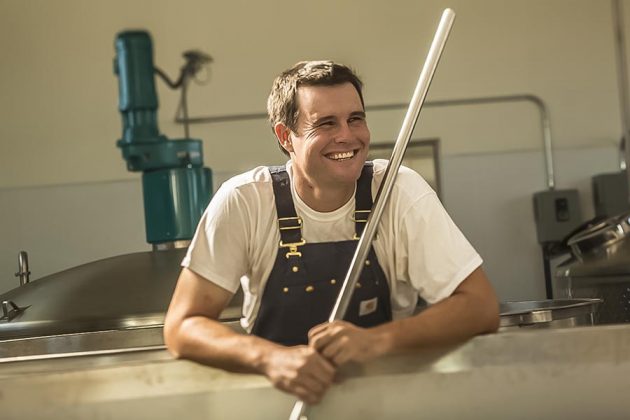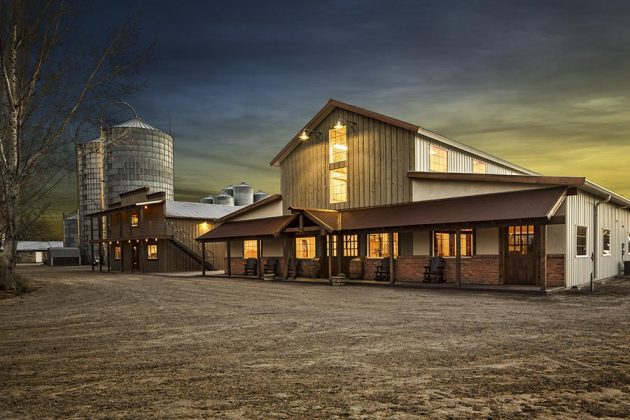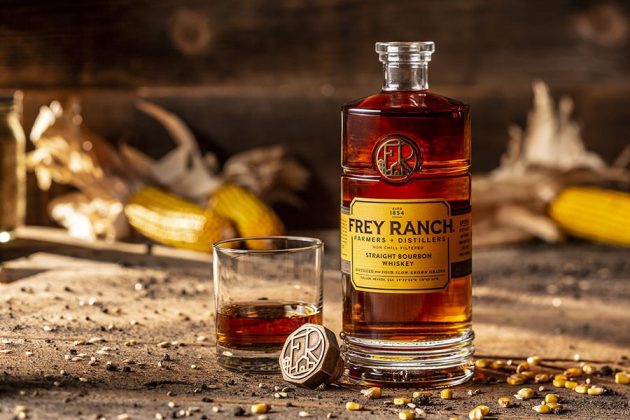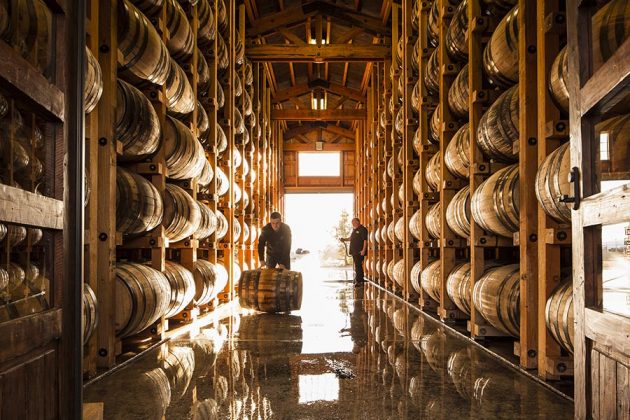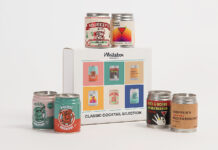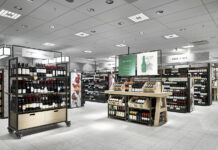Colby Frey knows a thing or two about adversity. His family has been farming in western Nevada for 165 years, 10 years before the territory became a state. The Freys have weathered droughts, depressions, dust storms and numerous other disasters over the past century and a half and have always come out the other side. The pandemic is no different, even though the timing couldn’t be worse. Back in 2014, Colby and his wife Ashley built a state-of-the-art distillery on their farm in Fallon, Nevada, to turn their own grain into whiskey. Five years later, the first whiskey was finally ready. Frey Ranch Bottled-in-Bond Straight Bourbon Whiskey first hit the market in December 2019, just a few months before the pandemic hit. But Frey Ranch is in it for the long haul, and the Freys always knew there would be unexpected setbacks along the way. That’s just what life is like for whiskey farmers.
Whiskey Farming in a Nevada Oasis
That’s what Colby has taken to calling himself — a whiskey farmer. That’s even what it says on his business card. “It’s the best way to describe me,” he shrugs. “I’m a farmer who makes whiskey, you know?” Frey Ranch, after all, is one of just a very few true estate distilleries, — although Colby has largely given up on using that term, opting instead for the tagline “Farmers + Distillers,” which more fully encapsulates the distillery’s vision.
“In the wine world, people understand that estate wineries farm all their own grapes, but in distilling it’s more nebulous,” explains Colby. “Many distilleries, including some big brands, use the term ‘estate distillery’ when they source from local farms, even if they don’t grow the grain themselves. ‘Farmers + Distillers’ just represented us better.” That’s because Frey Ranch (the distillery) truly does grow all of its own grain on Frey Ranch (the farm). The Freys farm about 2,000 acres in Fallon, which provides more than enough corn, wheat, rye and barley (plus a smattering of other grains, for experimental purposes) to supply the distillery. The distillery even malts its barley on-site. “We’re really fortunate here because we can grow extremely high quality corn, wheat, rye and barley,” Colby says. “We even grow some oats. A lot of places might only be able to grow one or two of those things really well.”
If your only exposure to Nevada is Las Vegas, it may come as a surprise that the state has much agriculture at all. Nevada is, in fact, the driest state in the country, and most of it is desert. But not all of it. Frey Ranch is located in the heart of Nevada’s small agricultural belt, about an hour east of Reno. “Fallon is the oasis of Nevada,” Colby says. “We get very little rain, but we have a lot of water here. All of the water comes from the Sierra Nevada watershed, from both sides of Lake Tahoe.” That reliable and sustainable water source turns what would otherwise be a cold desert into a small pocket of great agricultural productivity.
That doesn’t mean farming in the area is necessarily easy, but that’s where experience comes in. “Through 165 years of trial and error, my forefathers have passed on what works, and even more importantly, what doesn’t work, to grow these crops in this specific area,” Colby says. The Freys know how to take advantage of the hot days and cool nights, the strong seasonal temperature swings, and the elevation (around 4,000 feet above sea level). Those conditions all contribute to bountiful crop growth, and they also happen to be great conditions for maturing whiskey.
Selling the Farm
Colby and Ashley Frey, with distiller Russell Wedlake, knew from the moment they broke ground on the distillery that they were in it for the long haul. They never planned to release their whiskey before it was ready and at least four years old. Four years turned into five. The extra year gave the whiskey a little more time to mature, but it also gave the Freys time to truly hone in on their marketing. A whiskey farm in the middle of Nevada is an unusual proposition, and while the quality of the whiskey would always come first, the Freys knew they had to invest in the branding and messaging to get the word out there.
Frey Ranch worked with a design firm to develop its overall look and messaging, and the results speak for themselves. Frey Ranch’s bourbon comes in a custom bottle engraved on the bottom with the words “Be good to the land and the land will be good to you,” which encapsulates the Frey family’s philosophy. “That’s the foundation of the bottle and also our foundation as farmers,” Colby says. “If we don’t take really good care of the land, then we don’t have a future. It’s really important to us to not take without giving back to the soil and our farm and our climate.” The bottle has a heavy metal topper and a label shaped like Colby’s belt buckle, which was originally his grandfather’s: “We wanted something modern, without being too old-timey Western.” It’s a custom bottle, and they had to speak to four bottle vendors before finding one who could actually make what they wanted, but they accepted no substitutes and eventually got what they wanted.
Rapid Gains Until the Pandemic
Frey Ranch launched its flagship bottled-in-bond straight bourbon whiskey, 5 years old and aged entirely in full-size barrels, in December 2019. The initial release was limited to the relatively small northern Nevada market (which includes Reno) and quickly gained traction. “I think we were in over 300 locations within a week and we sold almost 1,000 cases in that initial launch,” Colby says. This was particularly impressive considering the launch window; most distributors consider December one of the worst times to launch, since retailers and consumers have already spent most of their holiday money. “Our distributor said it was the exact opposite of what they anticipated, and the best launch that they’ve ever had,” Colby says.
Frey Ranch expanded to Las Vegas this February. Because the distillery only had about 4,000 cases to sell and was committed to a 5-year age statement, it leaned into a heavy focus on on-premise sales. The brand started gaining early traction, just in time for the state’s casinos and bars to shut down in late February. A quick pivot to the Nevada off-premise market hit another wall when most liquor stores were temporarily shut down. Overall, Frey Ranch has focused on the off-premise more than it initially planned but has also tapped into online sales through Bounty Hunter Rare Wine & Spirits, a California-based retailer with a robust online presence that can ship to a number of states. Overall, sales still outperformed the distillery’s post-COVID projections, while coming in under the initial pre-COVID expectations. Although the timing certainly wasn’t ideal, it doesn’t faze the Freys. “As farmers, we’re always dealing with both Mother Nature and with volatility in different markets,” Colby says. “We’re almost used to it.”
He attributes the whiskey’s strong pre-COVID traction in part to the distillery’s patience. “We’ve been selling vodka, gin, absinthe, brandy and other things, but for five years we’ve always been telling everybody that we’re a whiskey distillery. There was a lot of pent-up demand.” In addition, very few craft distilleries launch with a five-year-old whiskey that they made themselves. For better or for worse, many consumers still associate craft whiskey with small barrels and short age statements, but Frey Ranch bucked the trend. “Waiting to put out a five-year-old was a good thing because everybody was surprised at how good it was. I think that really helped us quite a bit.”
Frey also attributes its early success to a commitment to working closely with its distributor, Southern Glazer’s Wine and Spirits, which is both the largest distributor in the country and a powerhouse in Nevada. Adapting to have a greater focus on the wholesale market took a mindset shift but has quickly paid dividends. For example, in the past, the distillery would launch new projects with a tasting or release party at its distillery and only get products into distribution after the launch party. For the bourbon launch, Southern Glazer’s seeded the new release in stores first. The Freys still held an official launch party at the distillery, and gained extensive local media attention, but because the product was already in stores, consumers could immediately go out and buy the bourbon. “People could go to the store that day, after seeing it on the news, and grab a bottle,” Colby says.
Future Plans
Although the bourbon launch was successful, the pandemic has certainly slowed down plans for expansion. Frey Ranch had planned to start rolling out in the Sacramento market in March and was just days away from launching when the pandemic lockdowns led their distributor to put a moratorium on new products. The distillery finally started its California launch in July at the same time as it launched its straight 100% rye whiskey, which is also five years old and bottled-in-bond but available in much more limited quantities. Frey Ranch doesn’t have a concrete time line for further expansion, but the distillery has a substantial amount of whiskey aging ( around 6,700 barrels) and eventually plans to distribute to all 50 states.
The pandemic itself hasn’t dramatically changed life on the farm. Like most distilleries, Frey Ranch got into the hand sanitizer business this spring. “Once they allowed us to make hand sanitizer, we made a lot, but we didn’t sell any of it,” Colby says. “We donated it to all the local essential businesses and services, the naval air station in Fallon and every hospital around us. If we can keep one person from getting it and passing it on to 10 people, we’ve done our job.” Beyond that, Colby admits that quarantine in rural Nevada isn’t so bad. “We’ve got the ideal location to be stuck at,” he says. “If you’re going to be isolated and quarantined, the best place to be is right here on the ranch. I thought I’d get a bit of a breather, but we’re just working twice as hard on the farm before the distillery gets busy again.”
Once the pandemic ends, Colby looks forward to being able to actually visit markets to promote the brand. He’s already preparing. “I’ve had my pilot’s license since 2008, but I never had an airplane. So, I bought a little Cessna and now I can get to Las Vegas in an hour and a half and be on my own schedule, versus driving an hour to Reno and taking a flight from there. I plan to travel a lot, except for the spring and the fall, because I’m busy planting and I’m busy harvesting.” In the long run, the pandemic will likely be just a speedbump on Frey Ranch’s road to whiskey success. “It sucks, but we’ve been waiting so stinking long anyway,” Colby says. “The whole plan from the beginning was not to release it before its time, even if it took five years or six years or however long it took. That mentality has really helped us, because we’ll be able to weather this storm.”

